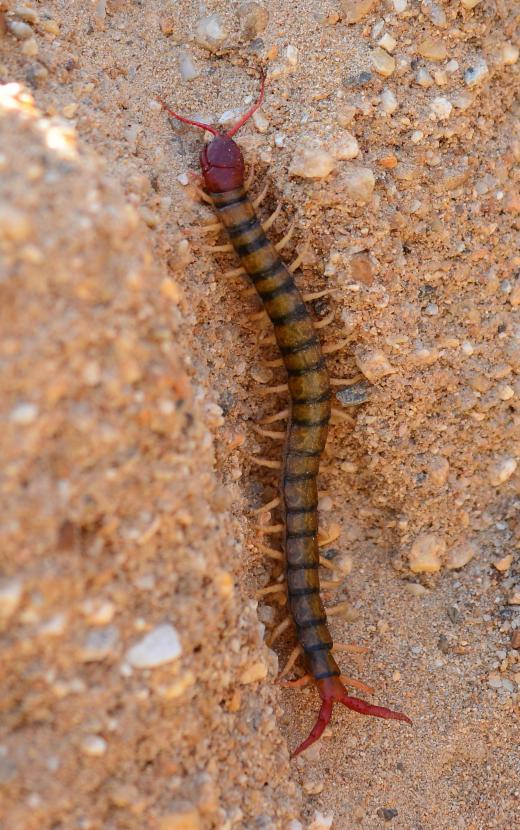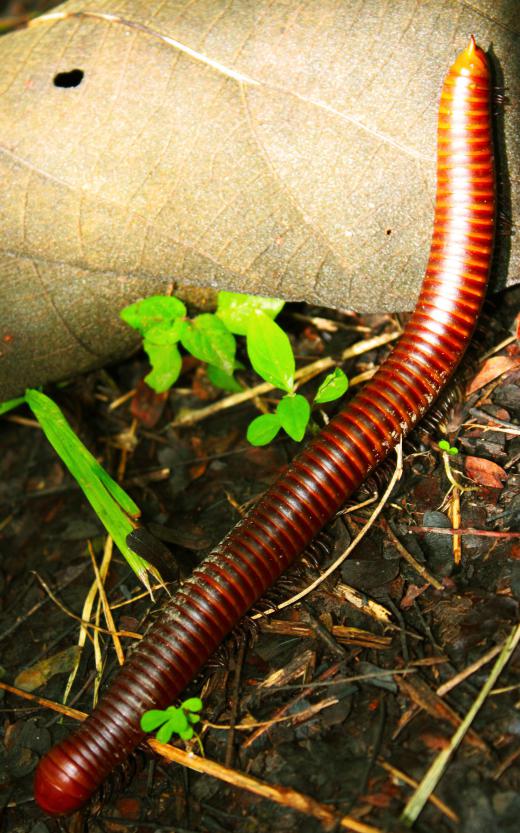What are the Major Groups of Myriapods?
 Michael Anissimov
Michael Anissimov
Myriapods are members of Myriapoda, a subphylum of arthropods. They include the familiar millipedes and centipedes as well as the very small and rarely seen symphylans and pauropodans. Myriapods are the first known land animals, with one fossil of a millipede dating back to the late Silurian, 428 million years ago. It is known to have been terrestrial because of the presence of small breathing holes called spiracles. There is the possibility that myriapods are even older, as molecular evidence indicates a major diversification episode in an even older era, the Cambrian, and there are some Cambrian fossils that may be myriapods.
The most familiar and largest myriapods are the millipedes and centipedes, many-legged arthropods whose number of legs ranges from under ten to 750, depending on species. Both live in decaying plant material, though millipedes actually eat the leaf litter while centipedes prowl it for prey such as small insects. Millipedes and centipedes look strikingly different, as centipedes have long legs that stick out to the sides while millipedes usually have their legs contained beneath their body. All species of myriapods are terrestrial, but millipedes may be amphibious during rare instances.

Centipedes are voracious predators, fast and venomous. They mostly hunt at night, and have a terrifying appearance, though they are of little danger to humans. Unusual for a taxon, they are exclusively predatory, and the defining feature of the group is a set of venomous front claws. Their name means "hundred feet," though they usually have only a couple dozen. The smallest centipede is Nannarup hoffmani, at about half an inch in length, while the largest is Scolopendra gigantea, the Amazonian giant centipede, which reaches over 30 cm (12 inches) in length. The Amazonian giant centipede has been known to eat bats (catching them in mid-flight), rodents, and large spiders. In all, there are about 3,300 known centipede species.

Millipedes are less scary than centipedes, both in appearance and behavior. They look like extended pill bugs, meandering through detritus for edible leaf matter. Millipedes move more slowly than centipedes and have more body segments and legs. The distinguishing characteristic of millipedes is that each pair of body segments is fused into a single unit, making it look like each segment has two pairs of legs. Millipedes display more diversity than centipedes, with about 8,000 known species. One species, Illacme plenipes, a rare millipede found in central California, has 750 legs, the most of any known animal.
AS FEATURED ON:
AS FEATURED ON:












Discussion Comments
One year we had a really wet spring and these unusual looking bugs were all over the outside of our basement.
When some of them got inside the basement, I had to figure out a way to get rid of them. It turns out they were a type of millipede. If you looked at them closely you could see how many tiny legs they had all up and down their body.
Because the ground was so saturated, they had no place to go and were really a nuisance that year. I went to the local garden center to get something to spray them with. It was pretty expensive, but it worked.
That was the only year I remember having a problem with millipedes like that. They must be around all the time, but because of all the rain, they showed up in places where you didn't usually see them.
I never spent too much time learning about arthropods when I was in school. I never wanted to see them or study them, and hoped I never had any close contact with them.
I don't know how something so tiny like a millipede or centipede can bother me so much, but they do. I just want to get as far away from them as possible.
My sister dated a guy once who was really into this kind of thing. Thankfully, that relationship didn't last very long. I realize we need people who study and understand myriapods like this, but I don't think it will ever be me.
Post your comments